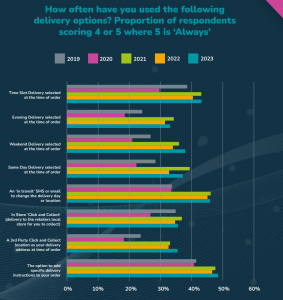By Ellie-Rose Davies, Content Executive at IMRG
Optimising the post-purchase customer experience is crucial for customer acquisition and retention. This is even more important during economic downturns, when customers are more hesitant to complete a purchase.
UK customers have significantly reduced their spend with online retailers in the last couple of years, meaning that when they do spend, retailers should create an excellent experience that would prompt reengagement.
This blog takes you through the top ways to improve the post-purchase customer experience, focussing on checkout strategies and communication techniques, as well as methods to add value and reduce hassle for customers.
Give customers the options they want
Customers’ wants and needs are becoming more complex; they expect fast and reliable delivery, as well as the option to be able to select a delivery option that suits them best.
As Nick Williams, Director of Parcel Services at PayPoint Plc says, ‘It’s important online retailers are guaranteeing convenience at every stage of the delivery process. By offering a range of delivery options, sharing regular updates on the status of customers’ orders, and ensuring items can be collected and returned with ease, retailers can ensure that they meet the needs of all their customers, enhancing customer satisfaction and driving repeat orders.’
Delivery options that customers always use are highlighted on the chart extracted from IMRG’s Consumer Home Delivery 2023/4 report. One of the main takeaways you can get from this data is that customers want choice and flexibility. The most used option is adding specific delivery instructions to their order (48.5%), followed by the ability to change delivery day or location (45.9%).
Weekend delivery (38%) and third-party click & collect selected at the time of order (35.5%) became more popular in 2023. Going beyond standard offerings will draw in those last-minute shoppers and it can prompt conversion.

Liam Rogan, Out of Home Director at Yodel exclaims that ‘Customers in 2024 are looking for more choice and will often opt for retailers that give them flexibility in the delivery of their items. While home delivery remains a popular choice, we are seeing more customers embrace out of home deliveries, opting for store locations that fit within their daily routine.’
He says, ‘By offering this at the checkout, customers can collect their item at a time and location that works for them. When recommending this delivery option, we see reduced ‘where is my order’ (WISMO) queries and customers can access a service that consistently see’s high CSAT scores.’
Improve your communication
Customers value communication at each stage of the purchasing journey. Communication is often ample at the browsing stage, but it is also increasingly essential at the post-purchase stage.
Melike Ulaman, Content Marketer at Prisync emphasises this, saying, ‘One effective way to offer excellent customer experiences post-purchase is by providing personalised follow-up communication, such as thank you emails or messages with relevant product recommendations.’
‘Additionally, offering exceptional customer support through various channels like live chat, phone, and social media helps promptly address post-purchase concerns.’
Founder and CEO of parcelLab, Tobias Buxhoidt, also describes the value of post-purchase communication, emphasising how ‘Providing regular updates on order status, estimated delivery times, and clear instructions for returns can significantly boost customer trust and satisfaction. Personalising this communication adds value – recommendations for additional purchases should be relevant and timely.’
‘Implementing a feedback loop post-delivery to gather insights and improve services is also crucial,’ says Tobias. Relevant communication can ‘transform customers into brand advocates,’ aiding retention.
Gavin Murphy, CMO at Scurri shares, ‘Our research highlights that the majority (90%) of consumers see continuous post-purchase updates as a non-negotiable part of the purchasing journey.’
Gavin explores how retailers can use a rules-based approach ‘that can tailor delivery communications for every online customer purchase, automated for scale. Also, by adding several filters, retailers can send emails for orders over a certain value for VIP customers or based on the SKU, or if a customer needs to sign to accept their order, send them a reminder when their item is out for delivery.’
After having sent post-purchase communication, Gavin recommends retailers to look at ‘marketing metrics that include bounce rates, for order tracking emails, open and click-through rates, and traffic and engagement on the order tracking page.’
Add extra value
As explored, ‘Leveraging personalised recommendations for complementary products showcases understanding and adds value’ says David Taylor, Country Manager at Aramex. But a way to add extra value is ‘surprise gifts or exclusive offers to further delight customers, creating memorable moments.’
David explores how ‘implementing thoughtful strategies’ can generate desired outcomes. He says, ‘Beyond the transaction, it’s about nurturing engagement, fostering loyalty, and delivering exceptional service.’

Lee Metters, Brand Partnerships at Awin also explores the value of adding a gift with purchase; ‘Using brand partnerships enables retailers to upsell their customers to a complementary brand offer. In turn, retailers can enhance their customers shopping experience, incentivise customer loyalty, and drive inbound revenue through brand ad-spend.’
He continues, ‘One of the most successful forms of brand partnership is ‘Gift with Purchase’ whereby the retailer offers customers a free gift from another brand post-purchase. Brands like Myprotein, Boohoo and Currys have all made a success of this in recent times. Offering a gift at checkout can also boost basket completion, by up to +40%, driving significant incremental volume.’
The key is to work with brands that share complimentary customer demographics, without being direct competitor.
Another way to give customers extra value at the post-purchase stage is offered by Bill Schneider, VP of Product Marketing at SheerID. He gives an example of ‘a big box retailer that gives teachers an exclusive offer, verifies their identity, and enrolls them in its loyalty program when they redeem it.’
Bill says, ‘Then it re-engages them with relevant, seasonal promotions, like discounts on apparel and school supplies during back to school and holiday breaks. The teachers become loyal customers because they feel recognised and valued by the retailer.’
Optimise your returns
IMRG research has shown that customers find the following aspects very important for convenient returns: confirmation their parcel has been received (86.8%), access to tracking information to confirm the safe arrival of a return (79.1%), and access to a convenient drop-off location (72.9%).
A significant proportion of the 1000 customers surveyed (60.1%) revealed that they would also like a returns collection service where you can specify the time slot. While collection services may not always be possible, it is good for retailers to consider how their current offering can be more customer-centric. Can their returns portal provide accurate tracking, and offer extra benefits such as faster credit?
Alexandra Romantseva, returns expert at ReBound highlights the importance of foregrounding returns. She says, ‘Given that a third of consumer purchases now lead to returns, according to the latest ReBound data, the post-purchase experience is now inextricably linked to a retailer’s reverse logistics.’
‘Retailers can benefit from being smart with their returns, monitoring consumer behaviour, analysing reasons for returns, and ensuring customer happiness,’ says Alexandra. ‘By using data to improve efficiency and accuracy, brands can then drive customer-centric policies by streamlining the process. This could include offering different returns options, making the experience quicker and improving customer loyalty.’
Fraudulent returns have been on the rise, says Amal Ahmed, Director, Financial Services & EMEA Marketing at Signifyd. Consequently, ‘retailers have resorted to charging returns fees to cover the costs. But, as we found in our recent research, 60% of European consumers would be less likely to shop with a business that charged for returns.’
Amal recommends ‘Retailers should instead focus on verifying users, enabling free, fast returns and refunds while fighting fraud.’
Reduce extra hassle
When customers purchase from an online retailer, they may be met with unexpected hassle, creative a bad customer experience.
Nicole Morton, Cross-Border Solutions Manager at Avalara reflects on issues that can occur for international customers; ‘No retailer wants customs delays, surprise costs, or unhappy customers. Yet failing to assign accurate Harmonised System (HS) codes to shipments could result in all three.’
‘HS codes are six-digit identifiers assigned to every product sold internationally. Carriers and couriers will not necessarily ensure the correct ones are assigned on behalf of businesses, as they lack the information to do so.’

Nicole continues, ‘However, where it’s necessary for carriers and couriers to assign HS codes, there’s a strong chance of them being incorrect. Getting HS codes right can be a quick win to improve the post-purchase experience.’
Monica Eaton, Founder at Chargebacks 911, explains how the lack of 24/7 customer service can ruin the customer experience and bring problems for retailers. Without this ‘you’re inviting customers to resolve issues with their bank, rather than with you. Banking apps offer 24/7 dispute resolution portals, and they’re happy to meet customers’ needs when you’re unavailable.’
‘One of the most effective ways to prevent payment disputes and chargebacks is to make returning items to your business the most attractive option for customers. Even when round-the-clock live service is not possible, you still have options. Help desk tools, customer service chatbots, and other services all exist to provide at least some response to customers at all hours,’ says Monica.
Monica shares that, ‘In line with 24/7 support, it is also a good idea to provide customers with the tools they need to resolve problems on their own, when possible, e.g., a categorised list of support articles and FAQs for common issues.’
Want to read more? Here are some other IMRG blogs that cover a range of ecommerce topics:
8 Red Flags Your Checkout Is Not Optimised For International Customers – IMRG
Ecommerce Quick Wins After A Difficult Start To 2024 – IMRG
Tax Changes To Be Aware Of In 2024 – IMRG
How UK Retailers Can Face The Challenges Of Increased Demand – IMRG
Using Interactive Marketing To Drive Customer Engagement – IMRG
Published 27/03/2024



